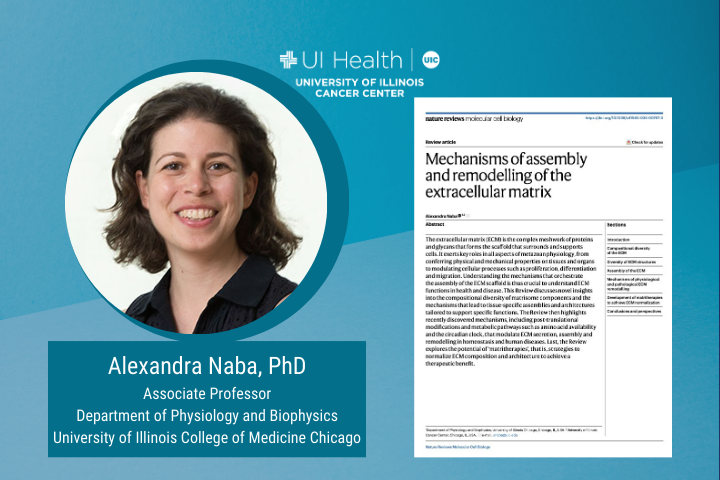
An article published in Nature Reviews Molecular Cell Biology by University of Illinois Cancer Center member Alexandra Naba, PhD, proposes the concept of “matritherapies” to benefit patients with pathologies that originate from or are aggravated by extracellular matrix (ECM) disorders. The ECM is an ensemble of proteins that make up the scaffold organizing cells, tissues and organs.
Part of the Cancer Biology Research Program at the Cancer Center, Naba pioneered the application of proteomics to study the ECM. She is also founder of the Matrisome Project and the database MatrisomeDB, two major resources for ECM research used worldwide. Naba is an Associate Professor in the Department of Physiology and Biophysics at the University of Illinois College of Medicine Chicago.
In the article, Naba acknowledges Dharma Pally, PhD, a postdoctoral fellow in the Naba Lab, for proposing the term ‘matritherapy’.
The conclusions and perspectives section from article, “Mechanisms of Assembly and Remodelling of the Extracellular Matrix,” is excerpted below.
“The past few decades of ECM research have demonstrated that the ECM is not an inert scaffold. Instead, ECMs are complex and diverse in their composition and architecture, and undergo constant, yet tightly regulated, remodelling. Many questions pertaining to ECM assembly and functions remain unanswered. For example, we have yet to build a spatially resolved atlas of the ECM at single-cell resolution to determine the positioning of ECM components with regard to each other. The ECM of a given tissue or organ is the result of a multi-scale assembly and we still do not know precisely which cell populations secrete ECM proteins, which populations secrete ECM modulators and, finally, which cell populations express receptors for these ECM proteins. Consortium-led mapping efforts, such as the NIH Human Biomolecular Atlas Program, should help to address these open questions. In addition, until now, many aspects of ECM biology have been studied in isolation and in vitro, but all aspects of ECM biology are intertwined: the biochemical composition of the ECM directly affects its physical and mechanical properties and signalling functions. There is thus a crucial need to devise integrated approaches to perform system-level analyses of native ECMs together with the cells they support. Last, sustained efforts aimed at deciphering the fundamental aspects of ECM metabolism, from synthesis to secretion to assembly and post-assembly remodelling, are of paramount importance if we want to be able to devise successful matritherapies to sustain healthy ageing and benefit patients with pathologies that originate from or are aggravated by ECM disorders.”
